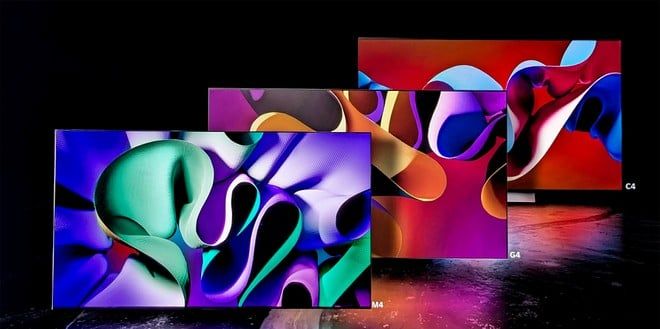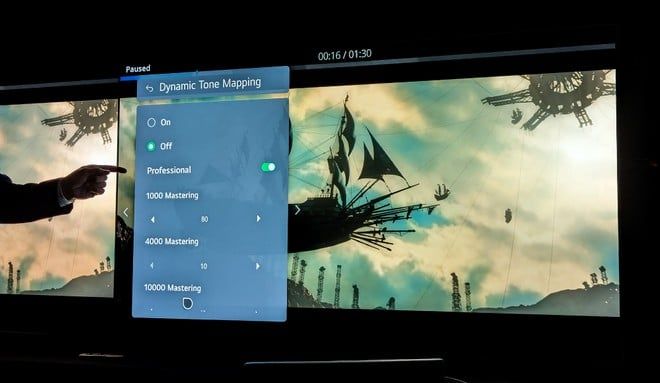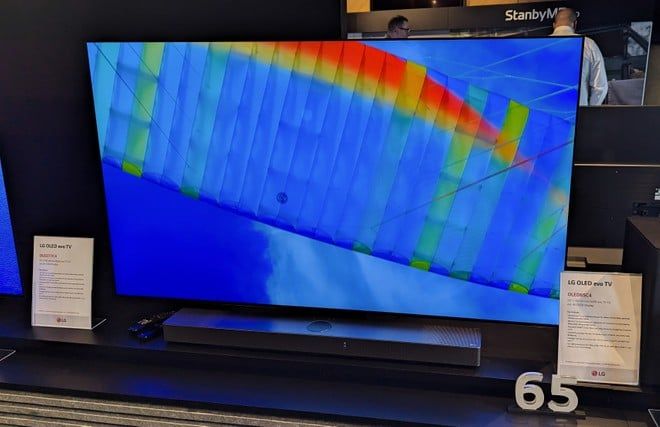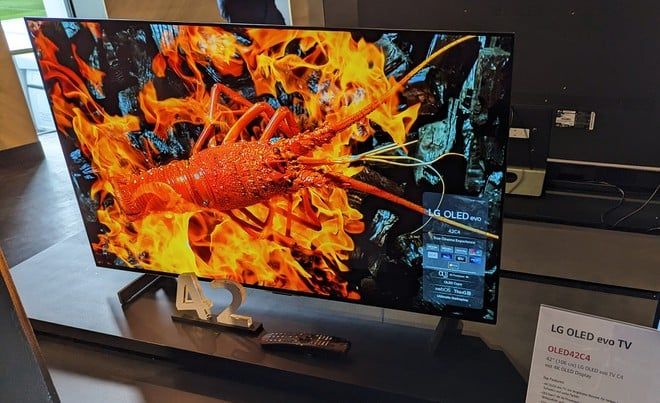On the occasion of Convention 2024 – which took place in Germany in the splendid setting of the Eintracht stadium in Frankfurt – LG has unveiled the entire range of OLED televisions intended for the European market.
The models are therefore confirmed G4, M4 (wireless), C4 and B4 series OLEDswith availability on the Italian market of series B4 and C4 from mid-Aprilwhich will follow a few weeks later the G4 series and finally it will close towards the end of the year with the M4 series and also with the transparent and scenographic Signature OLED T (which however was not present and for which no further details were added compared to the Las Vegas announcement).
OLED G4 AND M4 WITH MLA 2, ALPHA 11 AI AND 144HZ PROCESSOR

As regards the flagship series G4 and M4 all the features announced at CES 2024 in Las Vegas have been confirmed, with the addition of some further details regarding the functionality of the new Alpha 11 processor AI and the declination of the G4 series models for the Italian market.
We therefore find the integration of new 4K Ultra HD WRGB OLED panels with second generation MLA microlenses for cuts from 55 (diagonal not available for the M4 series), 65, 77 and now even 83 inches (the 97 inch does not yet integrate this innovation) which therefore sees a further increase in peak luminance in HDR, capable of reaching 3000 nits in 3% window thanks to the “Peak Highlighter” of the Brightness Booster Max (a mix achieved thanks to the characteristics of the panel, combined with the heat dissipation plate and advanced electronics management).

All models integrate now native 144Hz panels (also in Proprietary G-Sync VRR), with the functionality which, however, must be activated by the user via a specific item within the menu dedicated to gaming (this is to avoid any conflicts with the HDMI EDIDs). The doors obviously remain present HDMI all in version 2.1 at 48 Gbps (four for the G4 series and three for the M4 series on board the Zero Connect Box for wireless signal transmission).

As always, HDR compatibility is broad and supported HDR10, HLG, Dolby Vision and HGIG for gaming (therefore only HDR10+ is missing), with Dolby Vision which from this year will also be able to count on the “Filmaker Mode” preset calibrated, free of processing and optimized for playback of cinema content in a dark room, such as HDR10 and SDR.

Still on the subject of HDR, LG implemented the ability to manually adjust the roll-off point of HDR static metadata this year to bypass its tone-mapping (an option that was already present, for example, on Panasonic OLED televisions). This is a feature that is rightly highlighted as “Professional” as it can only be useful for those who want to try their hand at HDR color correction of their footage or, possibly, define a dynamic range for HDR video games.
Further refinements were then made to the factory HDR tone-mapping of these series: thanks to the new panels and the power of the processing (with relative increases in luminance peaks), “static” tone mapping is significantly improved for all contents up to 4000 nits peak and, as was demonstrated to us during the technical workshop, we can easily do without the dynamic tone-mapping processes (which can still be activated and are also further revised and improved).

Much emphasis was then dedicated to the AI (Artificial Intelligence) developments made by new Alpha 11 processor which promise to meet the requests of the general public in terms of detail, sharpness, colors and “depth” of the images reproduced on the screen. If on the one hand we appreciate the undoubted improvements (especially on upscaling, which is truly surprising in various circumstances – see Youtube or highly compressed television content, but also the motion management of the renewed “Cinematic Motion” dedicated to 24p films), on the we do not agree with its overly invasive approach (see Object Enhancing or AI Director Processing which risk significantly distorting the initial photograph of the reproduced content).
The power of Alpha 11 then allows audio upmix up to 11.1.2 channels and improved dialogue intelligibility thanks to artificial intelligence processing “Voice Remaster” (which manages, in real time, to isolate voices and make them clearer within the sound context).
They were finally implemented new voice search featurescomplete with voice recognition (Voice ID) and related automatic profile settings within webOS 24, as well as support for the new “AI Chat Bot” voice to help you use and optimally set your TV. Features that will initially be available only for the Korean and US markets and that they will then also arrive in Italy by the end of the year.

Speaking of updates, LG has confirmed the five-year upgrade of the webOS operating system, with version 24 which can therefore go up to webOS 28, both in terms of graphical interface, new features and security upgrades. Compared to the new ranges, the operating system updates of the previous generation models will be released during the following year. This means that the 2024 OLEDs will then receive the update to webOS 25 during 2026 and so on up to webOS 28 which will therefore arrive in 2029. The same goes for the current range on the market equipped with webOS 23 which will therefore receive webOS 24 during 2025.

The G4 and M4 series will be able to count on 5 year warranty on panels And the G4 series will arrive in Italy in two versions: with pedestal stand (initialed with S at the end) only for 55 and 65 inches And with Wall Mount Zero Gap wall bracket (signed with W at the end) for all models from 55 to 83 inches.
Italian prices recommended to the public are the following:
OLED G4
- 55″ – 2,399 Euros
- 65″ – 3,199 Euros
- 77″ – 4,699 Euros
- 83″ – 6,499 Euros
OLED M4
- 65″ – 3,999 Euros
- 77″ – 5,499 Euros
- 83″ – 7,499 Euros
- 97″ – 29,999 Euros
OLED C4 WITH ALPHA 9 PROCESSOR AT GEN 7 AND 144HZ

The new OLED C4 series will be available in denominations 42, 48, 55, 65, 77 and 83 inches and incorporates many of the features expected for the most prestigious series. However, it is worth highlighting the absence of the panels with microlenses, the dissipation plate and the related top performances in terms of HDR luminance peaks. However, LG confirmed the use of new generation 4K Ultra HD “EVO” panels which ensure, however, an increase in peaks in HDR compared to the previous 2023 C3 range.
As always, the 42- and 48-inch cuts hit lower HDR peaks compared to models with larger diagonals (due to the more reduced dot-pitch which penalizes their efficiency), but this year there has also been a slight increase in peak performance for the smaller models.
The C4 series uses now 144Hz panels for the entire range and maintains the extensive HDR and tone-mapping support that we have already highlighted for the G4 and M4 series, as well as the presence of the renewed operating system webOS 24related features and update policies.

Here too we find the integration of 4 x 48Gbps HDMI 2.1 portswhile on the processing front, the C4 series uses a Seventh generation Alpha 9 AI SoCwhich therefore renounces the most advanced AI processing (such as Object Enhancing, AI Director Processing, Virtual 1.11.2CH surround or Voice Remastering), while maintaining theAI Super Resolution & Noise Reduction (which however intervenes with analysis and processing per frame and not per pixel as for Alpha 11), as well as the new algorithms dedicated to motion management (the new one is particularly effective “Cinematic Motion” dedicated to content at 24 frames per second).
Italian prices recommended to the public are the following:
- 42” – 1,299 Euros
- 48” – 1,499 Euros
- 55″ – 1,799 Euros
- 65″ – 2,599 Euros
- 77″ – 3,999 Euros
- 83″ – 4,999 Euros
OLED B4 WITH ALPHA 8 AI PROCESSOR, 120HZ AND 4 HDMI 2.1

Marking LG’s entry-level OLED range this year will be the B4 seriesavailable in diagonals 55, 65 and 77 inches (the 48 inch available in other markets, will not be distributed in Italy) and which involves the use of WRGB 4K Ultra HD panels with maximum refresh rate of 120Hz.
Peak HDR performance is lower than that of the C4 series (but will still be higher than the current B3 series), but this year the “B” series sees the integration of 4 HDMI 2.1 ports all at 48Gbps and the use of the unpublished Alpha 8 AI SoC (which now integrates almost all the processing planned for Alpha 9).
For the rest, the main features essentially follow those of the C4 series, with Multi-View limited to two portions of the screen and not four and the absence, for obvious reasons, of VRR G-Sync support up to 144 Hz.
Italian prices recommended to the public are the following:
- 55″ – 1,599 Euros
- 65″ – 2,399 Euros
- 77″ – 3,299 Euros

Finally, a word about QNED 2024 LCD TV rangewhich will see the integration of the new ones Alpha 9 AI gen 7 (QNED99) and Alpha 8 AI (QNED90 and QNED85) SoCs with related features in common with the respective OLED series, improvements in local-dimming and HDR tone-mapping managementthe arrival of a 98 inch model (QNED89which will have the functional characteristics of the QN85 series) and, above all, the great novelty of the use of VA type LCD panels for some diagonals, replacing traditional IPS (but, from what we understand, there will not be a fixed rule for specific “series and/or diagonals”, so we will have to be careful when purchasing). When and if we have more details about it, we will come back to it.
Italian prices recommended to the public are the following:
QNED89
QNED86-87
- 50″ – 999 Euros
- 55″ – 1,199 Euros
- 65″ – 1,499 Euros
- 75″ – 2,299 Euros
QNED80
- 43″ – 699 Euros
- 50″ – 899 Euros
- 55″ – 999 Euros
- 65″ – 1,299 Euros
- 75″ – 1,799 Euros
- 86″ – 2,999 Euros

















